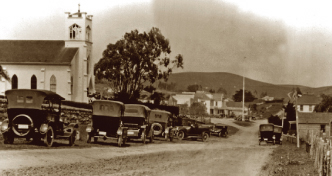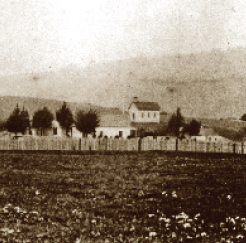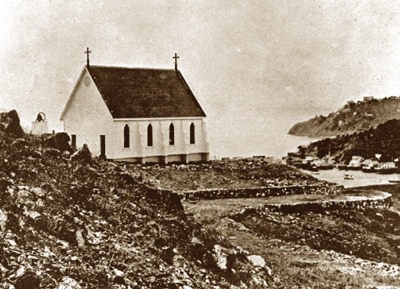Historians consider the founding of Mission San Rafael Arcángel on December 14, 1817, one of Marin’s most important days. The mission established San Rafael as the center of the county’s religious, social and business life. It also spawned four one-room Catholic churches that still play active roles in their communities. Here’s a closer look at their origins.
Church of the Assumption of Mary, Tomales
The Civil War was not yet under way when Tomales pioneer John Keys—who envisioned the town someday being the size of San Francisco—donated a plot of land on what is now Highway 1 to the first Archbishop of San Francisco, Joseph S. Alemany, for a church. Less than a year later, on March 8, 1860, the Church of the Assumption of Mary was dedicated. According to Barry Spitz’s Marin, a History, the wooden church cost $4,000 to build, a lofty sum for those days. The first baptism happened here within six months. The first pastor, the Rev. Louis Rossi, traveled by horseback from Healdsburg to deliver his sermons.
 Forty years later, with the congregation growing, ground was broken for a larger stone church. But the great quake of 1906 destroyed that building, and the original wooden church, whose foundation was damaged by the temblor, was repaired and pressed back into service. And it is still serving. Nowadays, the Church of the Assumption in Tomales has a beautiful plastered ceiling, seven colorful stain glass windows on each side, and three graceful cut crystal chandeliers. The Reverend Robert K. White leads Saturday night and Sunday morning mass, in both English and Spanish.
Forty years later, with the congregation growing, ground was broken for a larger stone church. But the great quake of 1906 destroyed that building, and the original wooden church, whose foundation was damaged by the temblor, was repaired and pressed back into service. And it is still serving. Nowadays, the Church of the Assumption in Tomales has a beautiful plastered ceiling, seven colorful stain glass windows on each side, and three graceful cut crystal chandeliers. The Reverend Robert K. White leads Saturday night and Sunday morning mass, in both English and Spanish.
Saint Mary’s Church, Nicasio
The founders of Nicasio, situated in the geographic center of Marin, envisioned the town as the county seat; in the early 1860s, a town square was laid out with this in mind. In 1867, the three-story, 22-room Nicasio Hotel and the graceful yet simple Saint Mary’s Church were constructed facing the square. Like Tomales’s Church of the Assumption of Mary, Saint Mary’s was built on land donated to Archbishop Alemany. This time construction was $3,000, thanks in part to use of locally cut and milled redwood. Saint Mary’s first pastor, the Rev. A. F. Herrington, rode in from Petaluma to deliver his sermons.
Today the church looks as it did in 1867. Two hitching posts and a white picket fence were added early on, but more functional wire fencing eventually took their place. In 1921, a thunderous Christmas Day windstorm blew down the steeple and knocked the building off its foundation. In 1958 a front porch was added to protect the handsome redwood doors from harsh winter weather and a gas heater replaced the nearly 100-year-old woodburning stove. The Native Sons and Daughters of the Golden West celebrated the church’s centennial in 1967 by placing a bronze plaque near the entry, indicating a historic monument. Saint Mary’s now hosts weddings, baptisms and Sunday and Thursday morning mass. The Rev. Cyril O’Sullivan officiates both here and at Saint Cecilia’s in Lagunitas.
Saint Mary Magdalene Church, Bolinas
 Though a Catholic cemetery was established in 1853 near the corner of the Olema-Bolinas and Horseshoe Hill roads in Bolinas, another 25 years passed before Saint Mary Magdalene (original spelled Magdalen) Church was dedicated at the same location. The land was a gift from Don Gregorio Briones, the owner of Rancho Baulines, who wanted a chapel near the Bolinas Lagoon. At the time, Methodist and Presbyterian churches had already been constructed in the area that soon became known as “Gospel Flat.” Today, only Saint Mary Magdalene remains.
Though a Catholic cemetery was established in 1853 near the corner of the Olema-Bolinas and Horseshoe Hill roads in Bolinas, another 25 years passed before Saint Mary Magdalene (original spelled Magdalen) Church was dedicated at the same location. The land was a gift from Don Gregorio Briones, the owner of Rancho Baulines, who wanted a chapel near the Bolinas Lagoon. At the time, Methodist and Presbyterian churches had already been constructed in the area that soon became known as “Gospel Flat.” Today, only Saint Mary Magdalene remains.
From its beginning it was a “mission” church, meaning it didn’t have enough parishioners to support having its own priest. The first pastor, the Rev. James Croke, director of St. Vincent’s orphanage near San Rafael, also officiated at the Mission San Rafael Arcángel. Located just a quarter of a mile from the San Andreas Fault, Saint Mary Magdalene survived the 1906 earthquake virtiually unscathed. Two years later, a distinctive bell tower was added and the church’s one room was extended by 10 feet to accommodate a new altar. Saint Mary Magdalene had its most active years during World War II when military personnel were stationed in West Marin. Recently, the entire church was jacked up so a new foundation could be constructed. The Rev. John O’Neil of Sacred Heart Church in Olema says mass here Sunday mornings.
Old Saint Hilary’s in Tiburon
In 1888 it took 80 days to construct this one-room church on a rise above the town of Tiburon. The builder was Peter Donahue, whose crews were also constructing the nearby rail yards. The architect is unknown, although Saint Hilary’s style is typically dubbed either Victorian or Carpenter Gothic. Most likely the design came out of a “pattern book,” as virtually identical churches still stand in Montana and California’s ghost town of Bodie. Historically, the church’s name refers to France’s fourth-century Bishop of Poitiers, Saint Hilary; it was also undoubtedly a nod to to Hilarita, wife of Dr. Benjamin Lyford, who donated the church’s land.
According to the pamphlet Old St. Hilary’s: The First One Hundred Years, the first communion took place at the church September 15, 1895, and the first wedding less than a year later. In 1911, a bell tower was built behind the church; sometime later a “sanitary privy” was added. Both still stand, although the privy doesn’t function. Until 1940, the church had no light, heat or running water.
By the late 1940s, Saint Hilary’s was deemed too small to serve the community and a new church was built two miles west. To differentiate the two, the original church was renamed Old Saint Hilary’s. In 1959, thanks to the efforts of the late Susanna Dakin and historian Beverly Bastion, the Belvedere-Tiburon Landmarks Society bought and restored Old Saint Hilary’s. Today weddings are held regularly held in the redwood chapel. On December 19 at 8 p.m., a women’s choir will present “The Rhythm of the Holidays,” one of a series of monthly concerts held in the church.
Image 2: Easter Sunday, 1919, Church of the Assumption in Tomales (Photo courtesy of Tomales Regional History Center)
Image 3: Saint Margy Magdalene Church, Bolinas, 1879


